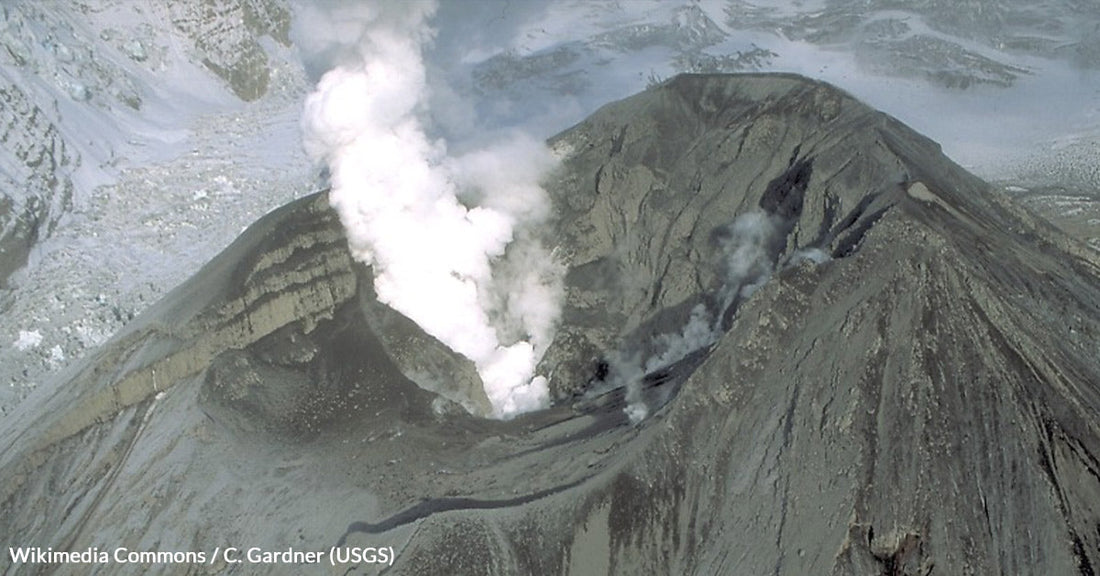Alaskans Rush to Shield Pets as Volcano Threatens Disaster
Matthew Russell
In Anchorage, Alaska, pet owners are doing more than just keeping an eye on Mount Spurr—they’re turning their living rooms into training grounds for canine PPE. With scientists at the Alaska Volcano Observatory warning that the 11,000-foot volcano may erupt within weeks or months, residents are stocking up not only on essentials like N95 masks and sealed water jugs, but also on goggles, booties, and dog respirators for their four-legged family members.
“We’re trying to just get him not to associate the goggles with torture and pain, but more of the treats,” said Jesslin Wooliver of her dog, Iroh, who’s being trained to wear heart-shaped protective eyewear using freeze-dried salmon snacks, according to NPR.

Photo: Wikimedia Commons / McGimsey, Alaska Volcano Observatory, U.S. Geological Survey, License: Public Domain
The 1992 Mount Spurr eruption coated the city in an eighth inch of ash.
Volcanic Ash Is Not Just a Human Hazard
If Mount Spurr erupts, the ash it releases won’t resemble the soft remnants of a campfire. Instead, it will be more like airborne shards of glass—fine, jagged, and capable of causing eye, skin, and lung irritation in both humans and animals. “This ash will be like tiny bits of ragged glass that can harm eyes, lungs, skin, pets, and livestock,” Dr. George Conway of the Anchorage Health Department told Alaska Public Media.
Officials in Anchorage have issued clear guidance: keep pets indoors as much as possible and use paw booties and eye protection if they must go outside. The city’s animal control team is also encouraging owners to consider canine respirators, noting that while they’re not common, they can provide a layer of protection from inhaled ash particles.
“If you can get canine respirators, fantastic,” Joel Jorgensen, spokesman for Anchorage Animal Care and Control, told NPR.

Photo: Wikimedia Commons / United States Senate - Office of Lisa Murkowski, License: Public Domain
Mount Spurr is showing signs of a pending eruption near Anchorage.
Booties, Doggles, and a Surge in Sales
Anchorage pet store AK Bark has seen an explosion in demand. Owner Mark Robokoff told NPR that March was their biggest sales month on record, with over 500 pairs of dog goggles—both the high-end Rex Specs and the more affordable Doggles—flying off the shelves.
“We needed to call in reserves,” he said.
The shop has also presold 1,800 canine respirators and stocked up on paw balm, hypoallergenic wipes, and raincoats.
“Wipes may save us all,” the store wrote on social media. “Wipe down everything (dogs included) before it comes in the house!”

Photo: Wikimedia Commons / C. Gardner (USGS), License: Public Domain
Volcanic ash can damage lungs, eyes, and skin of both people and animals.
Why the Rush?
The science points to urgency. Elevated volcanic gas emissions, rapid earthquake swarms, and land deformation around Mount Spurr are all signs of magma activity, according to experts at the Alaska Volcano Observatory. The same vent that erupted in 1992 is showing renewed signs of unrest.
“Each ash-producing episode could last three to four hours,” AVO scientist Matt Haney told DailyMail. He warned that ash plumes could rise 50,000 feet into the atmosphere and cover Anchorage and surrounding areas in volcanic dust.
While the volcano’s summit hasn’t erupted in millennia, its side vent—Crater Peak—last blew in 1992, sending ash across the region and causing widespread disruption. According to the Express, tremors have been steadily increasing, with some quakes occurring 65 miles below the surface—possibly linked to rising magma.

Photo: Wikimedia Commons / USGS, License: Public Domain
Experts say explosive plumes could reach 50,000 feet into the air.
Protecting Pets Without Panic
Despite the flurry of preparations, experts urge calm and practical planning. Dr. Sarah Coburn, Alaska’s state veterinarian, advised against suddenly introducing unfamiliar gear to pets.
“I wouldn't make any big changes for pets to something they're not used to doing or used to wearing,” she told Alaska Public Media.
Instead, sheltering animals inside and using tarps to limit exposure outdoors is recommended.
She emphasized monitoring pets for signs of ash irritation—eye pawing, excessive blinking, or skin issues—and using pet-safe wipes or rinsing them off after outdoor exposure. Drinking water should be replaced regularly to prevent ash ingestion.
For sled dogs or animals that must stay outside, even basic cover like a tarp “can make a difference,” Coburn said. And if ash does accumulate on fur or clothing, rinse it in a tub before washing to avoid damaging appliances.

Photo: Wikimedia Commons / U.S. National Archives and Records Administration, License: Public Domain
Volcanic ash is made of jagged particles of rock and glass.
Training with Treats, Not Trauma
Back in Anchorage, Iroh the dog is still practicing his mask routine. “We’re just trying to get him used to it now,” Alliana Salanguit told NPR. “He gets a reward when it gets taken out, a reward when it gets strapped on, and a reward when it gets taken off."
As Mount Spurr rumbles beneath its icy cap, the people of Anchorage—and their pets—aren’t waiting to be caught off guard. They’re prepping with purpose, one paw at a time.

